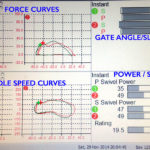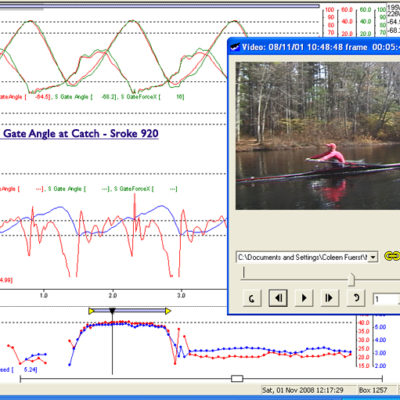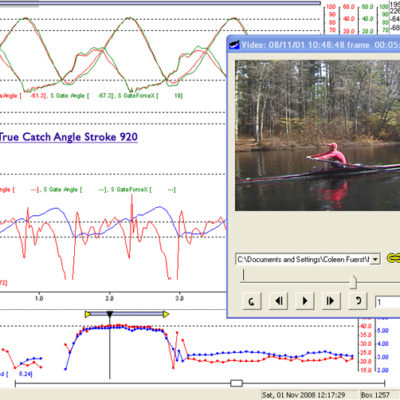The Tank As A Rowing Simulator:
The rowing tank has been used around the world for well over 100 years to teach oar-handling mechanics. Only recently, due to the availability of technology are we able to display the forces generated when rowing in the tank making the tank a true rowing simulator.
The mathematical simulation between boat Force and tank Force according to Newton’s 2nd Law is: (F = MA), where: Mass of boat x Acceleration of boat = Mass (of tank water impacting the tank blade) x Acceleration of tank blade. Nowhere in the simulation equation for force does water speed of the boat or the tank water appear. This refutes any reason for a mechanically assisted moving water tank.
Force Measurement In The Boat:
To explain further: Rowing in a moving boat involves the blade of the oar moving through still water. The blade (if correctly buried) only slips relative to the water along a defined path while translating in and out from the boat while generating a component of force that propels the boat forward. Due to the movement of the boat, the blade follows a curved trajectory first out from the boat and then back tracing a pattern similar in shape to a cursive small letter “e.
At racing stroke rates the water viscosity working against the blade speed reacts like a solid surface and resists getting out of the way. Since the oar attached to the blade is fixed to the boat at the pin, the blade is forced to move relative to the water first tip to tail and then once past the perpendicular, tail to tip.
In direct contrast, the rowing tank blade must be sized small enough in area so that it can rip through the surrounding water mass to generate its force while following roughly a circular arc. The trick to good tank design is to make the force magnitude represented by the impulse curve (Force x time) and handle speed curve (angular oar velocity x time) roughly equal to what is experienced in the boat by modulating blade size and oar mechanics.
Once the force simulation is satisfied between boat and tank to an acceptable degree, then real-time feedback training for rowing can be displayed in the tank to achieve an optimal stroke that is both economical and efficient at near to racing cadence.
Thanks to the technology available today, it is possible to display force and handle speed curves in the rowing tank similar to those that are experienced in the boat. These curves give real-time graphical feedback to the athlete using the tank. Curves displayed when rowing in the tank are similar enough to curves downloaded from a boat data logger so that an economic shape of the curve, area under the curve, and slope of the curve can be mimicked by all to practice synergism in the tank without disruption caused by wind, weather, or the interaction of other rowers. Rowers training in this way will over time quickly converge on a near identical force curve similarity. They will approach the symmetry of a shared optimal rowing technique.
However, this simulation only works based on Force simulation. Trying to simulate water speed is impossible for 2 reasons: 1. The mass of water in the tank is impossible to accelerate due to its large mass, and: 2. The drive time is too short (less than 1 second).
This seems confusing at first glance because moving water in a tank does seem like an easy and obvious simulation solution. However, it fits the old saying: “There is usually an easy and obvious solution to every problem, and it is usually wrong!”
In the boat, the acceleration or deceleration that we feel is mostly that of our bodies relative to the boat. Most of the time we are only aware of the water which we observe to be quickly moving relative to the boat when in actuality the water is actually still and the boat is moving relative to it, while at the same time our body is moving both relative to the boat and the water!
Although at very high ratings there is tremendous acceleration and deceleration of the boat it is not noticeable to the rower and if you ask the average rower when the highest acceleration or velocity of the boat occurs, hardly any will answer correctly.
Below are two sequential curves plus an embedded screen grab video from a sculler taken just before the catch, and at the true catch, We think that his curves, in general, represents a good example of efficient, fast rowing.
If you lock click and forth between maximum gate angle catch and true catch you will see how quickly the rower inserts the blade matching the relative speed of boat to water without any body movement other than his hands/arms. The catch is identified on the graph by the long, vertical, thin black curser line bisecting all the curves. Note the force curve (the smaller, almost rectangular shaped mountain at the top, overlapping the larger sinusoidal oar angle curve). In the just before catch curve you can see that force has barely started on the footboard just as he is about to quickly initiate the catch, with the blade just about to touch the water surface. Boat deceleration (red line) is at its maximum (off the chart!), and boat velocity (blue line) has decreased to its minimum. The velocity of the boat relative to the water is at about 5 m/s, its minimum. That is a graphical description of a very quick vertical speed of entry at the catch! Click to enlarge the following screenshots:
If you lock click and forth between maximum gate angle catch and true catch you will see how quickly the rower inserts the blade matching the relative speed of boat to water without any body movement other than his hands/arms. The catch is identified on the graph by the long, vertical, thin black cursor line bisecting all the curves. Note the force curve (the smaller, almost rectangular shaped mountain at the top, overlapping the larger sinusoidal oar angle curve). In the just before catch curve, you can see that force has barely started on the footboard just as he is about to quickly initiate the catch, with the blade just about to touch the water surface. Boat deceleration (red line) is at its maximum (off the chart!), and boat velocity (blue line) has decreased to its minimum. The velocity of the boat relative to the water is at about 5 m/s, its minimum. That is a graphical description of a very quick vertical speed of entry at the catch!
Now, look at the true catch. Cycling back and forth between screen grab #1 and #2 notice that the sculler’s body does not move, only the hands raise quickly. Note how quickly the boat responds (red curve) by going from extreme deceleration to extreme acceleration. Also note the extreme slope of the force curve, almost vertical terminating at about 75% of maximum. These extremes in acceleration/deceleration are not noticed since the rower is essentially motionless with respect to the boat, with the exception of the hand moving vertically. All the while the boat is moving at 5 m/s!
The Drive:
Notice that as the drive progresses the boat velocity stays at its minimum until well past the orthogonal position (when the oar is perpendicular to the boat). From there until the end of the stroke the rowers mass (which is about 6 times the boat mass), is trying to move the boat in the wrong direction – toward the start rather than the finish line). This mass resistance becomes exponentially less as the drive progresses, allowing the boat to accelerate and the velocity to increase due to oar handle acceleration. (i.e., shown by an increasing slope of the blue velocity line) At the same time, the handle speed curve has a noticeable upward slope from 100 radians to 200 radians. While the blade is in the water the steeper the slope of the handle speed curve the faster the boat. Boat velocity and handle speed are of course directly related.
When rowing in the tank there is, of course, no boat velocity. Tank handle acceleration is shown by an upward slope on the drive (i.e., top of the curve from left to right). This technique must be achieved without “washing out”.
Rewriting Newton’s 2nd law results in the Impulse/Momentum equation F x t = M x V. This should be familiar since Force and Time are the x, y coordinates for the Impulse (force) curves and F x t is the definition of impulse. So with Impulse equaling Momentum, we can define the rowing stroke cycle as: The drive velocity is the result of Impulse and the recovery velocity is the result of momentum.
Recovery in the tank: We don’t have boat velocity or acceleration curves in the rowing tank, and there is no useful driving force on the recovery in the tank from momentum because of the literally astronomical reversal in mass ratios from our predominant 6 to 1 when considering our mass to the boats mass which is supported by an almost frictionless surface of water, as compared to the mass of the earth which we are affixed to!
Instantaneous Tank Display:
Below is data curves from a display from an indoor tank equipped with force measurement instrumentation. Shown are instantaneous Force Curves (Impulse Curves) and Handle Speed Curves with a red “+” indicating the position of the port hand and a green “+” for starboard hand, which also indicates the relative positioning of the hands on both sets of curves. Note the bar graphs on the right side are refreshed once per stroke. The curves are from two 16-year-old scullers so we try not to be judgmental. The more accomplished sculler is on the right (stroke) side. The less accomplished with regard to technique is on the left (bow). Click to enlarge the following screenshot:

Reading the display going clockwise: Force curves are in the upper quadrant for both rowers with a red dot indicating port and the green dot starboard. The next quadrant is handle speed represented as a bar graph with the length of the bar representing stroke length and the relative starting point of each bar indicating the furthest catch angle for each side of each rower. Numerical catch angles are to the right of each bar. There is a threshold value of 10-newtons that has to be exceeded before the bar is shaded and that visually represents the true catch. The length of shading represents total effective stroke length until the 10-newtons threshold is crossed again. The goal here is to have no white showing at the start of the bar, indicating a quick catch. It is almost impossible to eliminate all the white at the end of the bar due to momentum, however excessive white area at the finish will indicate disengagement with the water i.e., pulling down into ones lap and washing out.
The 3rd quadrant shows power per side for each sculler in watts and stroke rate. This is not absolute power but relative power because the mechanics of the tank are so much different from the boat that it is beyond the calibration range of the software as it exists at this time.
The last quadrant shows the handle speed for each sculler. The shape and slope are similar to that seen in the boat, with the exception of immediately after the catch is more continuous mainly because the blade is being pulled through the water rather than being supported by the water and forced to match boat speed, as in the boat. The shape of the handle speed curve ends up looking like a “peanut”, curved downward at both ends with top and bottom mirroring one another. See the following video: (Refresh the Browser to view, then Click to Open)
This video shows the same two young scullers using the tank. You can hear me coaching them by questioning them: “When you accelerate your hands at the end of the stroke, what does that do to the shape of the (handle speed) curve?” In this way, they learn by doing, assisted by real-time feedback. This is a much quicker, and more long-lasting coaching method, that works so much better than hoping that they will interpret your words correctly.
From experience, we have learned that if the rower is self-coaching in the tank, he or she can only effectively look at one quadrant at a time. By playing the video over and over you should see most of the following takeaways: The bow person (left side) has trouble with the side-to-side synergism as compared to the stroke person (right side). The slope of the curve at the Catch is different between the bow and the stroke, and this is also reflected in the slip at the catch shown by the bar chart. What you can’t know is that the person in stroke seat has primarily sculled, whereas the bow person has primarily rowed sweep. The bow person is quite a bit taller while being short on each end of the stroke. You can see that there is less handle speed acceleration during the stroke from the bow person than the stroke. There is a different hand speed away from the release on the recovery by the two athletes, which does not help synergism.
Problems like these can be easily seen and identified by the rowers in real time as well as by the coach. From our experience, identical problems occur on the water and in the tank. Once pointed out, the problems can usually be quickly fixed.
Also during the practice, a video can be made of the output data along with a video of what the problems look like from the stern or side-view, side or bow view and sent via cell phone immediately to the athlete. This is a very powerful tool. When environmental conditions of wind and weather, or school constraints impact training time, then real-time tank sessions are a much better use of coaching time then on-the-water sessions.
By: Jim Dreher and Coleen Fuerst: 2/17/2017


